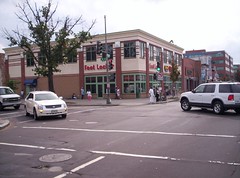Cropp suggests leasing school sites to builders
Is an article in today's Examiner. We were talking about this yesterday on the columbia_heights email list, where it seems as if this article was derived, although they chose to not contact me...
William Jordan (quoted in the article) started the thread with this:
During the recent mayorial debate held at UDC it was reported that during a discussion about the current School Modernization Bill, "D.C. Council Chairman Linda W. Cropp said she would reject a proposal to raise taxes for that purpose and would instead pay for school renovations by leasing the air space over public buildings, such as libraries, to developers." (WashingtonPost) This sounds reasonable but what does it mean? Is she really serious?
Anyway this is what I wrote:
The Sumner School renovations were paid for by the leasing of the playground to Boston Properties, on which was constructed a large office building. Rather than sell the land, it was leased for 99 years. Given how good (=bad) the DC Government is at maintaining properties, shockingly DCPS included in the lease requirements that the lessee (Boston Properties) would be responsible for both renovating the Sumner building as well as maintaining it throughout the term of the lease. For this reason, Sumner School is in good shape, while Franklin School is being sold off--"no money" for maintenance. (Oyster School was redeveloped similarly but the students lost the playground, because that's where the new building was constructed. Obviously the loss of a playground wasn't an issue for Sumner because it is no longer an active school.)
I can't claim to be an expert here, but I think this is more what CM Cropp is likely to be referring to rather than air rights. Most public buildings are in places with zoning restrictions. There isn't that much money in 20-40 feet of development rights over a school building, even if transferred because overall DC limits buildings at the highest to 160 feet. This ends up being a major constraint in terms of generating community incentives-benefits from development projects.
Certain locations offer more opportunity for redevelopment, such as library buildings in locations that either have more allowable height (Daniel Library on RI Ave.) or the branch in Tenleytown across from the subway station.
But there isn't all that much money around for this because of the site and height constraints. To get around that, things have to be given up. For schools that could include playgrounds. For other buildings, it might be rather than the "Buick vs. Cadillac" comment about the baseball stadium, it likely means serious reductions in the capabilities of what a building/project is "programmed" to be able to do. It means getting a Chevette probably, and one that was constructed during its model years of 1976-1987, not a car manufactured recently.
CM Cropp seems to be willing to cut amenities and quality in DC Government construction projects at the drop of a hat, and this willingness to compromise/degrade quality is something that needs to be considered when weighing decisions on who to vote for in the coming elections.
 This one-story building with a fake second floor was constructed with $1 million of federal monies awarded by the DC Dept. of Housing and Community Development. In the face of opposition from community residents and the Ward 6 Councilmember, Chairman Cropp cast the deciding vote in favor of this contract.
This one-story building with a fake second floor was constructed with $1 million of federal monies awarded by the DC Dept. of Housing and Community Development. In the face of opposition from community residents and the Ward 6 Councilmember, Chairman Cropp cast the deciding vote in favor of this contract. DC Government projects--Don't think about a Cadillac or a Buick, but a Chevette.
DC Government projects--Don't think about a Cadillac or a Buick, but a Chevette.The difference in perspective between virtually all the people who are elected to DC Government positions as well as many of the people who work for the various agencies is lamentably telling compared to Mayor Joseph Riley of Charleston, South Carolina.
Here's a short excerpt from Mayor Riley's stock speech:
We’ve resisted the bulldozer at every turn. You know, we started historic preservation in Charleston in the 1920s, and when we started working in poor neighborhoods, we just took that ethic uptown, believing that if it worked downtown, it should work uptown. And you know, cities need memories. Buildings are memories. We all need memories. We need memories, whether it’s a photograph album or memories or stories of grandparents, whatever. But when a bulldozer lazily bulldozes down — and at times they’ve got to go, but when you lazily do it — you rob the memories of the neighborhood or the community and it may take generations to rebuild something like that. We’ve done several hundred of these houses that look beyond repair. Host of different housing programs. Us, non-profits, for-profits, whatever. But it has changed these neighborhoods. These were neighborhoods where people were moving out. Crime rate was going up. Crime rate now is coming down. People are moving in. There’s a sense of pride, of home ownership. Rental, rehab, or whatever, but the heritage and memories of those neighborhoods are intact.
One of these days I am going to have a photo illustrated version of this speech... The images that Mayor Riley uses to illustrate this speech are really great.
Of course, being me, I wrote a follow-up email in response to something else that William wrote:
There was and is money to do projects on the scale of the Tenleytown Library. That could have been effected, but the Library Board and other groups weren't on board. Personally, I think it wasn't a bad idea. Mixed-use is what cities are about.
OTOH, the scale of need for schools is so much greater, that it stretches credulity that the average school could benefit from a development deal. What I mean is that could enough money could be generated to make a substantive difference, in a manner that seriously doesn't compromise the way the school serves its students and the neighborhood. (I.e., a story about Hewlett-Packard and their need to grow mentioned the scale issue, that to grow 1% they need $1 billion of revenue...)
Certain sites however, are looked upon quite avariciously, the Marie Reed Center being one of them. It may or may not be able to sustain such a development agreement. Another project that has been discussed, and a great amount of work been done, concerns the Spingarn campus. The urban design studio of the UM (sorry, Michigan, to me there is only one "UM") Architecture school did a big project for this site and offered a number of scenarios including mixed-use. (See this paper, "Designing a City of Learning" about the UM approach, )
I really do believe that "business process redesign" is in order. The school system gets a lot more money for many fewer children than in years past. I have a hard time believing that there isn't enough money out of $700 million to educate students. The physical plant is another story, but I don't have too much faith in the various proposals bandied about thus far.
I had a brief blog entry about this last week, which summarized some stuff I wrote in June and July, but I wrote a lot in August as well:
"Even More on Schools";
"School Days Continued;"
"Philadelphia Center City Schools Initiative;" and
"Charleston's First Day Festival."
Note that CM Cropp is saying "leasing" rather than "sale" which indicates that the People's Property Campaign, spearheaded by Parisa Norouzi and EmpowerDC, seems to be having some impact.



0 Comments:
Post a Comment
<< Home